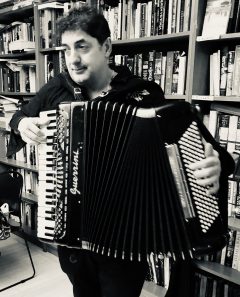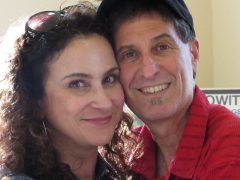Tales From The Road
Long Live the Free Reeds! Peter Stan and a Brief History of the Accordion
As I sit here in my quaint apartment with a balcony view of Prague’s “Old Town” spires, I can hear a busker below playing Bach’s Fugue in G Minor on the accordion. More likely than not, an accordion busker in America would be performing some ethnic folk dance, and there’s a good chance it came from Central Europe, like the polka.
In San Diego, one can most often hear accordionists playing Norteño music. Hapsburg Emperor Maximilian I (1863-1867) helped to bring the music of Middle Europe to Mexico. By 1864, he had accumulated marching bands and musicians to entertain him. When Maximilian’s empire fell, many of his former army and fellow countrymen fled north and dispersed into what is now the southwestern United States. Norteño music was developed from a blending of Mexican and Spanish oral and musical traditions, military brass band instrumentation, and Germanic musical styles such as polka and waltz. European immigrants from Germany, Poland, and former Czechoslovakia migrated to northern Mexico and the southwestern United States, bringing the accordion music of their home countries and integrating it into Mexican music. The instrument is essential today to Norteño because it is most popular in the northern regions of Mexico.
Like so many of the instruments played today throughout the world, the accordion traces its roots to China. The free reed instrument created in China (1100 B.C.E.) was the sheng. The sheng had between 13 and 24 bamboo pipes, a small gourd that acted as a resonator box and wind chamber, and a mouthpiece. Other instruments using a free vibrating reed were developed in ancient Egypt and Greece. Centuries later, the sheng attracted the attention of European musicians and instrument builders after being introduced in Russia in the late 18th century. There were many varieties of the free-vibrating reed instrument during the early 19th century. The concertina was created in England, the bandoneon in Germany and, eventually, the harmonium in France. Early models of this pipeless organ (harmonium) required a second person to pump air into the instrument through bellows attached to the rear of the keyboard. Many churches in America used the harmonium until the advent of electric organs in the 1930s.
The first accordion to feature a piano-style ivory keyboard was produced in Vienna in 1863. Musicians immediately took to this new design because it freed them from being confined to the cumbersome massive and immobile walls of the pipe. The keys were smaller than those on the piano and rounded to allow for greater dexterity and speed while playing. In 1857, Matthias Honer (1833-1902) originally a clockmaker from Trossinggen, Germany, decided to make a version of the accordion that was available at a reasonable price so many working people (miners, textile workers, farmers, etc.) would be able to purchase it. Soon this instrument began to be mass produced and became the go-to instrument in the United States by the turn of the 20th century through the 1940s for many European immigrants. On many an evening, one could hear on the streets people singing and dancing the polka, mazurka, oberek, and waltzes, played by the accordion—the “working class” instrument that began its journey over one thousand years ago in China.
When music conservatories (particularly in Russia, Ukraine, Belarus and Moldova), in late 19th century, began to teach classical music on the accordion, the instrument formerly seen as only a “folk” instrument, became one taken with great seriousness. Classical composers from Tchaikovsky to Alan Hovahness composed repertoire especially for the accordion, while others arranged Bach and Vivaldi. Today the accordion is heard as a classical solo instrument with some of the most prestigious orchestras in the world. The unique sound of the accordion made inroads in popular music as well here in America, especially in rock ‘n’ roll, with some classic bands: the Beatles, Rolling Stones, Emerson, Lake & Palmer, the Beach Boys, and Bob Dylan. Today, such bands as the Bare Naked Ladies, Counting Crows, DeVotchKa, the Dropkick Murphys, Mark Knopfler, and many other contemporary artists have fallen in love with the pulsating rhythms and scintillating melodic and harmonic lines that were introduced to American audiences back in 1989 with the film Time of the Gypsies by the Bosnian-Serb director Emir Kusterica about Roma life in Yugoslavia. Then his award-winning film Black Cat, White Cat (1997), a farcical comedy set in a Roma village, really caught the world’s attention, particularly the film’s soundtrack by Kusterica’s own band, No Smoking Orchestra. The music from the film became an international hit (some say much more than the film), helping to set the stage for many musicians to begin playing Roma music, blending it with different rock styles, including punk.
On July 11, San Diegans will have the chance to hear one of the greatest accordionists in the world today, Peter Stan, who is Serbian Romani. I have known Peter since 1995, when he became a member of my klezmer ensemble Hot Pstromi. Stan was raised in Australia until the age of 12, when he moved to Queens, New York with his family.
At an early age, he began to learn to play the accordion and was taught by his father, also an accordionist, for many years. As is common among Roma musical families, the father often passes his talents down to his children. Stan is one of three boys and is the only professional musician among them. He went on to study formally in several music schools and won many accordion competitions. Stan plays many styles of accordion, from classical to Balkan Romani to French musette to klezmer. He has performed with many different ensembles all over the world. With Hot Pstromi, he has performed in Hong Kong, all over North America, and in Europe, and with Slavic Soul Party he has performed in Canada and Zimbabwe. His music has graced many famous stages, including Carnegie Hall and the Library of Congress. And he has recorded on many film, cable, television and Off-Broadway soundtracks.
When I first heard Peter play with Hot Pstromi, I knew right then he would be the musical piston driving the energy of Hot Pstromi. One of the beauties of Stan’s playing is when he takes an improvisational solo; one never knows where he is going to take it. Sometimes he’ll go into some typical Romani Balkan riff, other times he’ll quote Rimsky-Korsakov’s Flight of the Bumblebee. At the July 11th concert, in addition to playing klezmer tunes I collected during my many ethnographic treks to Eastern Europe (many of which I learned from Romani musicians who were the last in their particular locale to play any klezmer music since there were no more Jews there) we will also perform some specific pieces I composed for Stan. These range from classical to Latin and everything in between. Joining Stan on the stage will be Elizabeth Schwartz (vocals), Fred Benedetti (guitar), Gunnar Biggs (contrabass) and myself on violin. Stan does not play often in San Diego so this is not a concert to miss.
For more information and tickets contact: www.museumofmakingmusic.org/events/yale-strom








